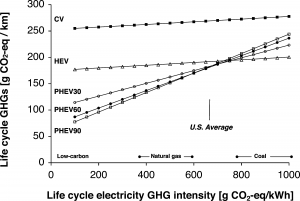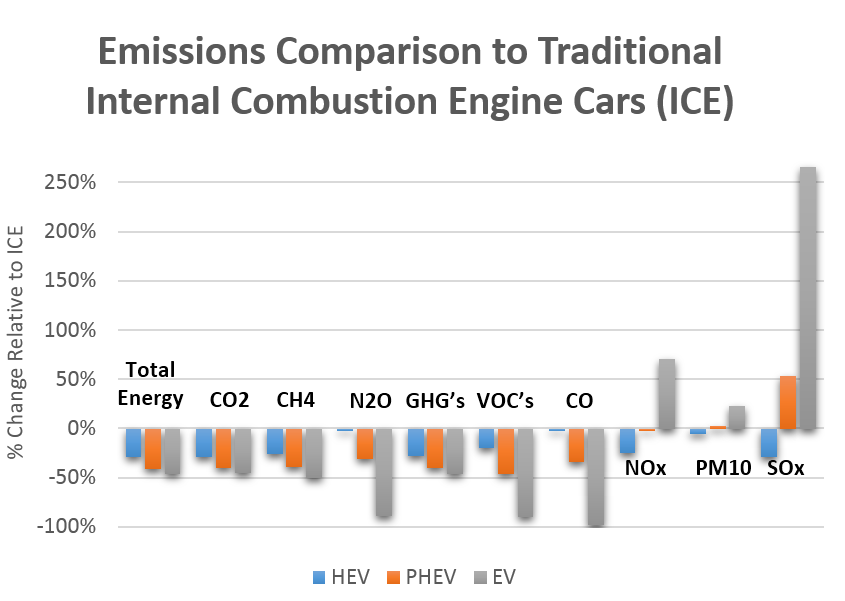Global Climate Change
The effect of PHEV’s on global climate change is linked heavily to the greenhouse gas intensity of the fuel source of electrical generation. This effect is demonstrated perfectly in Figure 1, which compares the life cycle emissions of PHEV’s with different ranges and the greenhouse gas intensity of the electricity source.

This figure shows that as the greenhouse gas intensity decreases, the effectiveness of PHEV’s increase. That is important to the effect of PHEV’s on global climate change because it shows that if the emissions of the grid were reduced, then the impact of PHEV’s on climate change would be much greater.
This raises an important issue; PHEV’s will have a marginally lower environmental impact when compared to HEV’s in the current electrical landscape. However, as the grid improves so will the impact of PHEV’s. This improvement would be nice; but compared to the magnitude of change that would come from changing the whole electrical grid, the impact of PHEV’s would be relatively insignificant.
Environmental Pollutants
The environmental pollution of alternative fuel vehicles are often compared to that of internal combustion engine vehicles as a standard to see the relative impact of each vehicle. Figure 2 shows this plot for many different pollutants.

This figure compares the lifetime emissions of various alternative fuel vehicles. It shows clearly that alternate fuel vehicles reduce the emissions of combustion gasses and greenhouse gasses proportionately to their use of electric energy. The drastic increases for EV’s and PHEV’s come mainly in pollutants that are results of power generation.
Economic Development
The introduction of PHEV’s into the marketplace will aid economic development, new technologies increase competition and provide different avenues for research. In addition to those factors, PHEV’s reduce the United States dependence on foreign oil which is an economic and national security benefit. One technology that will flourish because of this product is the battery sector, that is the limiting constraint of much of electrical vehicle technology, so a huge boom could come in the battery sector if batteries with longer range and lifetimes were invented.
Environmental Justice
PHEV’s create a few environmental justice issues. First, PHEV’s reduce tailpipe emissions which is good for those who live in proximity to roadways, but they concentrate the burning of fuels to power plants and create more power generation. This has various EJ implications, to begin it negatively impacts those who live close to power plants, but it also could lead to increased coal mining and other industries which have localized negative externalities. Another EJ issue is the increased production that goes into these vehicles, the mining of lithium is energy intensive and has had many previous issues with waste handling. Finally, PHEV’s are more expensive than traditional vehicles. There is a large tax incentive to drive a PHEV, but many people can not achieve that benefit because they are priced out of the market.
Environmental Policy
There are various policies which provide an incentive to purchase a PHEV, but the future of this policy needs to come in infrastructure and electrical generation changes. For electric vehicles to succeed in the US, they need to be more convenient to use. One policy could promote the construction of high voltage charging stations at many workplaces and cities. And as stated above, electric vehicles are only as clean as their electricity, so any policy to promote clean electricity would promote cleaner electric vehicles.
References
Nordelof, A., Messagie, M., Tillman, A., Soderman, M., & Mierlo, J. (2013). Environmental impacts of hybrid, plug-in hybrid, and battery electric vehicles. Modern Individual Mobility,
Elgowainy, A., Burnham, A., Wang, M., Molburg, J., & Rousseau, A. (2009). Well-to-wheels energy use and greenhouse gas emissions analysis of plug-in hybrid electric vehicles. Argonne National Laboratory,
US Department of Energy. Emissions from hybrid and plug-in electric vehicles. Retrieved 4/19, 2015, from http://www.afdc.energy.gov/vehicles/electric_emissions.php
Samaras, C., & Meisterling, K. (2008). Life cycle assessment of greenhouse gas emissions from plug-in hybrid vehicles: Implications for policy. Environment Science Technology,
Author: Justin Pié
Editor: Raji Gunasekera